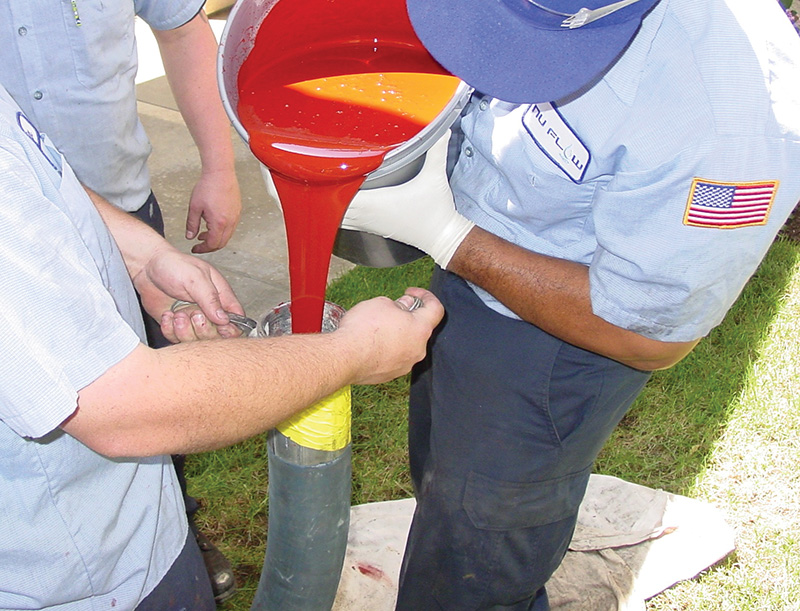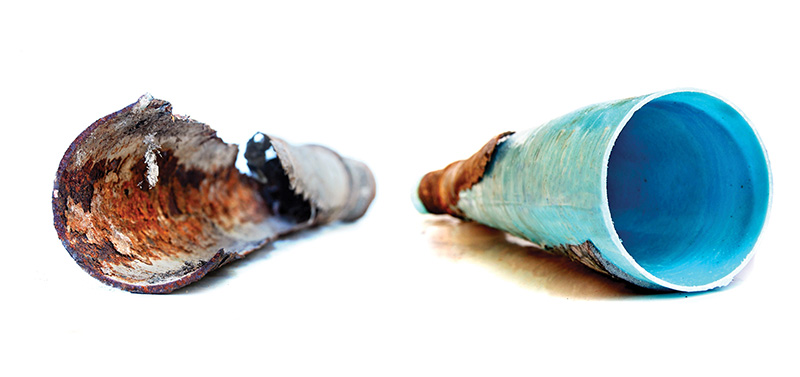How to prevent pipe failure by using pipe lining technology.
By Alyscia Sutch
For years, property managers, municipalities and even homeowners have resorted to traditional pipe replacement methods to fix their cracking, leaking and root intruded pipes. The process to dig up and replace the pipes is not only time consuming, but the renovation costs can be expensive, especially in a situation where pipes are located behind finished walls, underneath tiled flooring or below landscaped lawns. This costly and invasive process is avoidable. There are solutions available that can be used as a preventative measure to protect your aging pipes both inside and outside of the building.
A traditional repipe consists of demolition of whatever is covering the pipe, whether it is a tiled floor in an entranceway, a ceiling in a restroom or the parking lot of your retail facility. If the pipes were located in the ground, the system would be shut down, followed by the concrete foundation being dug up and removed, along with any fill. The pipes would then be removed and discarded. The new pipes would then be installed, tested and the fill would be delivered. Once completed and after much downtime, the pipes are operational. Contractors would then need to repair the walls, floors or ceilings destroyed during the repipe. If you’re able to prevent the inevitable pipe failure by using structural liners for drain lines or epoxy coatings for potable and mechanical systems, the avoided downtime and cost savings makes the solution worth looking into.
 With pipe lining, it is important to keep the proper perspective on what results are being accomplished. Old drainpipes are getting rehabilitated back to a usable pipe; the pipes are being recycled without removing them and creating landfills full of construction waste. Lining companies want to provide a cost-effective solutions to owners of buildings and homes, and owners want a cost-effective way to solve their slowly failing infrastructure without destroying the building in the process.
With pipe lining, it is important to keep the proper perspective on what results are being accomplished. Old drainpipes are getting rehabilitated back to a usable pipe; the pipes are being recycled without removing them and creating landfills full of construction waste. Lining companies want to provide a cost-effective solutions to owners of buildings and homes, and owners want a cost-effective way to solve their slowly failing infrastructure without destroying the building in the process.
Most facilities built prior to the 1970s have sewer lines composed of cast iron and clay. The most common problem in these lines is cracking at the joints, root intrusion and the bottom of the pipe rusting out; this can ultimately be a result or lead to root intrusion. Root intrusion in sewer pipe systems is reported to cause 50% of all sewer blockages. Traditional care for root intrusion is rarely a long term fix. With the pipe lining method, roots can be removed and a liner can be pulled into place, creating a structurally sound pipe within the existing pipe. Other common problems include calcification in sewer lines and ground movement. Millions of linear feet of drain and lines have been saved using the pull-in-place process.
Today, the most effective and growing solution for failing pipe systems both inside and outside of buildings is pipe lining technology. Liners are pulled into place inside the pipe systems without destruction and can protect the pipes from many types of common failures, including debris buildup, corrosion, leaks and root intrusion. Most importantly, pipe liners protect the carried contents from mixing with the metals within the pipes, which can result in decomposition or lead leaching into drinking water. Not only are potable water lines and drain lines being rehabilitated, but the technology to retrofit vertical applications, roof drains and mechanical systems — including fire suppression and HVAC systems — is available.
 Pipe lining technology requires no digging or destruction and is the most effective, long term solution for failing pipe systems located both inside and outside of buildings. Pipe lining is the optimal solution to increase flow, eliminate root intrusion and prevent leaks. It can hold up to the structural strength of a new pipe, without the costly digging and replacement repairs. The drain lining project begins with mapping the internal plumbing system and camera inspection of drain and sewer lines. A plan is implemented to minimize disruption and afford the most efficient timeline for work completion. Depending on the lining method to be used, pipes may be drained and/or air-dried. After testing for leaks, the pipes are prepared for cleaning. The next step involves removing roots and calcite in order to return the pipe to its original functioning diameter. Removal methods may include jetting the lines or the use of pneumatic tools such as a scorpion cutter. Cast pipe may require additional preparation if there is significant corrosion or missing sections of pipe. Existing access points are used to pull an epoxy-saturated felt liner into the host pipe. This lining method provides the ability to line multiple 45° and 90° angles, as well as the option of lining specific sections of pipe without lining the entire length. Once complete, a final leak test and camera inspection is performed and the system is now a smooth, jointless pipe within the existing host pipe.
Pipe lining technology requires no digging or destruction and is the most effective, long term solution for failing pipe systems located both inside and outside of buildings. Pipe lining is the optimal solution to increase flow, eliminate root intrusion and prevent leaks. It can hold up to the structural strength of a new pipe, without the costly digging and replacement repairs. The drain lining project begins with mapping the internal plumbing system and camera inspection of drain and sewer lines. A plan is implemented to minimize disruption and afford the most efficient timeline for work completion. Depending on the lining method to be used, pipes may be drained and/or air-dried. After testing for leaks, the pipes are prepared for cleaning. The next step involves removing roots and calcite in order to return the pipe to its original functioning diameter. Removal methods may include jetting the lines or the use of pneumatic tools such as a scorpion cutter. Cast pipe may require additional preparation if there is significant corrosion or missing sections of pipe. Existing access points are used to pull an epoxy-saturated felt liner into the host pipe. This lining method provides the ability to line multiple 45° and 90° angles, as well as the option of lining specific sections of pipe without lining the entire length. Once complete, a final leak test and camera inspection is performed and the system is now a smooth, jointless pipe within the existing host pipe.
With many solutions available to help prevent pipe failure and replacement, it is no wonder that many property managers and municipalities are turning to trenchless pipe lining to rehabilitate their pipe systems and prevent the inevitable pipe failure.
— Alyscia Sutch is the marketing coordinator for Nu Flow Technologies licensing and manufacturing facility. Nu Flow Technologies manufactures, installs and distributes cost-effective, green repipe alternatives and no-dig solutions, including epoxy coatings for potable water lines and mechanical systems, and structural liners for drain lines.
